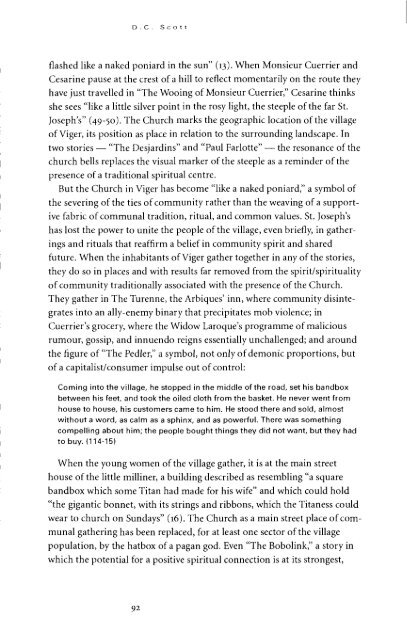The Carpathians - University of British Columbia
The Carpathians - University of British Columbia
The Carpathians - University of British Columbia
Create successful ePaper yourself
Turn your PDF publications into a flip-book with our unique Google optimized e-Paper software.
flashed like a naked poniard in the sun" (13). When Monsieur Cuerrier and<br />
Cesarine pause at the crest <strong>of</strong> a hill to reflect momentarily on the route they<br />
have just travelled in "<strong>The</strong> Wooing <strong>of</strong> Monsieur Cuerrier," Cesarine thinks<br />
she sees "like a little silver point in the rosy light, the steeple <strong>of</strong> the far St.<br />
Joseph's" (49-50). <strong>The</strong> Church marks the geographic location <strong>of</strong> the village<br />
<strong>of</strong> Viger, its position as place in relation to the surrounding landscape. In<br />
two stories — "<strong>The</strong> Desjardins" and "Paul Farlotte" — the resonance <strong>of</strong> the<br />
church bells replaces the visual marker <strong>of</strong> the steeple as a reminder <strong>of</strong> the<br />
presence <strong>of</strong> a traditional spiritual centre.<br />
But the Church in Viger has become "like a naked poniard," a symbol <strong>of</strong><br />
the severing <strong>of</strong> the ties <strong>of</strong> community rather than the weaving <strong>of</strong> a supportive<br />
fabric <strong>of</strong> communal tradition, ritual, and common values. St. Joseph's<br />
has lost the power to unite the people <strong>of</strong> the village, even briefly, in gatherings<br />
and rituals that reaffirm a belief in community spirit and shared<br />
future. When the inhabitants <strong>of</strong> Viger gather together in any <strong>of</strong> the stories,<br />
they do so in places and with results far removed from the spirit/spirituality<br />
<strong>of</strong> community traditionally associated with the presence <strong>of</strong> the Church.<br />
<strong>The</strong>y gather in <strong>The</strong> Turenne, the Arbiques' inn, where community disintegrates<br />
into an ally-enemy binary that precipitates mob violence; in<br />
Cuerrier's grocery, where the Widow Laroque's programme <strong>of</strong> malicious<br />
rumour, gossip, and innuendo reigns essentially unchallenged; and around<br />
the figure <strong>of</strong> "<strong>The</strong> Pedler," a symbol, not only <strong>of</strong> demonic proportions, but<br />
<strong>of</strong> a capitalist/consumer impulse out <strong>of</strong> control:<br />
Coming into the village, he stopped in the middle <strong>of</strong> the road, set his bandbox<br />
between his feet, and took the oiled cloth from the basket. He never went from<br />
house to house, his customers came to him. He stood there and sold, almost<br />
without a word, as calm as a sphinx, and as powerful. <strong>The</strong>re was something<br />
compelling about him; the people bought things they did not want, but they had<br />
to buy. (114-15)<br />
When the young women <strong>of</strong> the village gather, it is at the main street<br />
house <strong>of</strong> the little milliner, a building described as resembling "a square<br />
bandbox which some Titan had made for his wife" and which could hold<br />
"the gigantic bonnet, with its strings and ribbons, which the Titaness could<br />
wear to church on Sundays" (16). <strong>The</strong> Church as a main street place <strong>of</strong> communal<br />
gathering has been replaced, for at least one sector <strong>of</strong> the village<br />
population, by the hatbox <strong>of</strong> a pagan god. Even "<strong>The</strong> Bobolink," a story in<br />
which the potential for a positive spiritual connection is at its strongest,

















